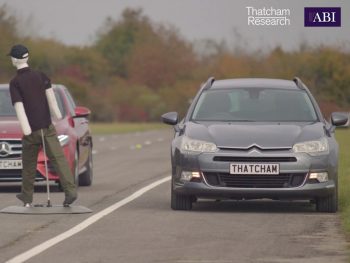Hands-free driving tech not safe yet for drivers, warns AFP
Doubts over the safety of forthcoming autonomous vehicle tech need to be resolved before fleets should allow their drivers to use it.

Thatcham says ALKS technology may not detect a pedestrian encroaching onto a carriageway – and if it does, it can’t change lanes
Automated Lane Keeping System (ALKS) technology could be in use on UK roads by early 2021 under a government consultation that closed last week. But Thatcham and the Association of British Insurers (ABI) have both said that such systems will “put road users’ lives at risk” and called for further research.
And now the Association of Fleet Professionals (AFP) has urged fleets not to let drivers – including in grey fleet vehicles – make use of the tech until safety doubts are eliminated.
The devices are designed to allow drivers to take their hands off the wheel and pass control to the car – and the DfT is looking to allow them to be used at speeds of up to 70mph on motorways at some point during 2021.
But AFP chair Paul Hollick said to fleets: “Our view is very firmly that employers should err very strongly on the side of caution and the doubts expressed by the ABI and Thatcham over the planned use of ALKS on motorways only underlines this position.
“The objections they raise about the limits of the technology and the speed with which drivers can re-engage with the on-road situation when they need to take over are genuine questions that need resolving before use on public roads is allowed.”
Thatcham has warned that while drivers might believe the tech can be completely trusted to do the job of a human driver, such systems are largely based on today’s Assisted Driving technology and are far from fully automated. It’s found that Automated Lane Keeping Systems only meet two of 12 key principles to guarantee safety and has identified motoring scenarios in which lives will be put at risk, as ALKS-equipped cars are bound by legislation that will not allow them to change lane autonomously.
Thatcham has also cautioned that the sensors contained within today’s assisted driving technology can only interpret up to around 120 metres. At motorway speeds, that distance allows only four seconds to take back control and avoid an incident – but current studies suggest a driver needs more than 15 seconds to properly engage and react appropriately to a hazard. That equates to 500 metres’ more required distance than today’s technology provides.
Hollick added the fleet sector will probably see a lot of debates of this kind over the next few years as the ADAS devices fitted to cars become more and more advanced and offer increasing degrees of autonomy. He also said there will doubtless be pressure for such systems to be made legal.
But he stressed: “For the foreseeable future, company car and van drivers should be keeping their hands firmly on the steering wheel. That is the responsible risk management position.”
This includes for the rising numbers of employees now in grey fleet vehicles.
Hollick outlined it was important that employers also ensured that the same rules were extended to grey fleet vehicles.
“Safety has to come first and it needs to be proven that any form of autonomy does not bring any inherent issues that could affect the well-being of drivers and other road users.”
ABIAssociation of Fleet Professionals (AFP)Automated Lane Keeping SystemsThatcham

















